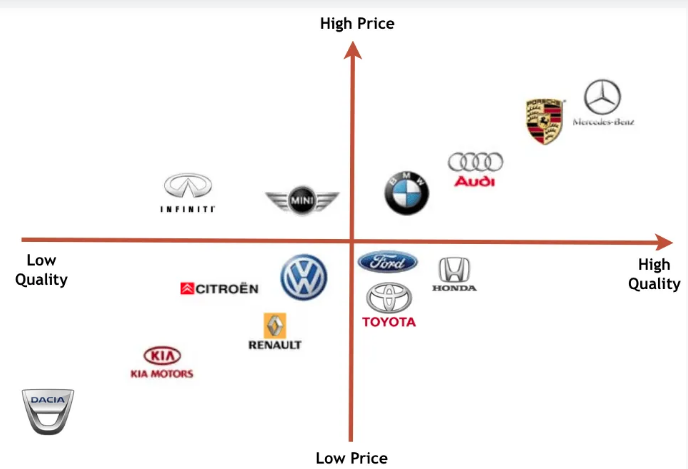Another Simple But Powerful Branding Tool
See Where You Need to Go to GrowAn Introduction to Market Positioning Maps
Like all maps, Market Positioning Maps (MPM) help you chart a course to wherever you need to go. They can also tell you where you are and what’s around you. If you think of MPMs this way, their value is easily understood.
First, let’s define some basic terms.
Glossary for Market Positioning Maps
X-Axis – this is the horizontal line that starts on the left side and go on forever to the right
Y-Axis – this is the vertical line that meets the x-axis to create perpendicular lines
Expected-price line – usually a diagonal line that shows how much customers expect to pay on average to get different levels of the primary benefit
Map Subject – there are an infinite amount of options for how you’d like to view your competition
Geographic Footprint – setting the boundaries of the map to focus results
Perceptual Map – a perceptual map is used to show consumer perception of certain brands. The map allows you to identify how competitors are positioned relative to you and to identify opportunities in the marketplace.
Now, let’s look at an perceptual map example from the automobile industry:

How to Create an Effective Market Positioning Strategy?
Create a positioning statement that will serve to identify your business and how you want the brand to be perceived by consumers.
For example, the positioning statement of Volvo: “For upscale American families, Volvo is the family automobile that offers maximum safety.”
1. Determine company uniqueness by comparing to competitors
Compare and contrast differences between your company and competitors to identify opportunities. Focus on your strengths and how they can exploit these opportunities.
2. Identify current market position
Identify your existing market position and how the new positioning will be beneficial in setting you apart from competitors.
3. Competitor positioning analysis
Identify the conditions of the marketplace and the amount of influence each competitor can have on each other.
4. Develop a positioning strategy
Through the preceding steps, you should achieve an understanding of what your company is, how your company is different from competitors, the conditions of the marketplace, opportunities in the marketplace, and how your company can position itself.
Sources:
About Cause Inspired
Cause Inspired solves problems for nonprofits large and small. Since 2018 when Google added us to their Ad Grants Certified Professionals list, we've found our way to the top of that list. Working with Google themselves, as well as the United Nations, Guidestar, Volunteer Match and hundreds of other nonprofits to provide answers to their marketing problems. Our main service is optimizing the Google Ad Grant. This expertise filters into our other digital marketing services: branding, retarget advertising, display advertising, social media advertising and website development.
If you're ready to talk about branding, the Ad Grant, or any other way we can help, please contact us.
For faster progress, contact Dave Barbush, Director of Marketing and Branding at Cause Inspired.
